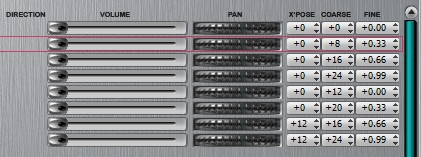I have been experimenting lately with alternate tunings and scales. A couple that have particularly piqued my interest are the Bohlen-Pierce scale and the much-less-used Bohlen 833 cents scale. The latter is intriguing in that it is based on properties of the fibonacci sequence and the golden ratio (although Bohlen admits he did not have those concepts in mind when he stumbled upon this scale).
Based on the golden ratio (1.618034…), one can construct a harmonic series as multiples of 833 cents that has a very distinct timbre. This can be easily implemented in Emulator X as a series of sinewave voices (or voices of any other harmonic single-wave sample) tuned multiples of 833 cents above the fundamental:

The series above consists of a fundamental, three golden-ratio harmonics, followed by the octave above the fundamental (traditional first harmonic 2:1 ratio), and the three-golden-ratio sub-harmonics of the octave.
Using these and other harmonics, Bohlen was able to construct the following seven-step scale between the tonic and the tone 833 above.
|
|
|
|
|
|
|
|
|
|
|
|
|
|
|
|
|
|
|
|
|
|
|
|
|
|
|
|
|
|
|
|
|
|
|
|
|
|
|
|
|
|
|
|
|
Emulator X does not have editable tuning tables, although it does have a 36ET tuning (36 divisions of the octave). Bohlen suggests that playing specific steps out of the 36ET scale yields a good appoximation of the 833 scale:
|
|
|
|
|
|
|
|
|
|
|
|
|
|
|
|
|
|
|
|
|
|
|
|
|
|
|
|
|
|
|
|
|
|
|
|
|
|
|
|
|
|
|
|
|
Combining the Bohlen 833 scale and harmonic series, which are both based on the golden ratio yields a new tonality. Although it is quite different from the traditional Western tonality based on integer ratios, it is nonetheless “harmonic” with respect to its own overtone series. This is perhaps a simple counter-example to to the Monk's Musical Musings from an earlier article.
But how does it sound? To that end, I provide the following audio example consisting of the scale played on the 833-timbre in Emulator X, along with some additional intervals. Because this is only an approximation using 36ET, things aren't perfectly “harmonic,” but I think one can get a feel for the tonality. I particularly like the “tri-tone” (600 cents above fundamental) here.
The next steps are to come up with a more musical timbre based on the harmonic series, as well as short composition using the scale…
